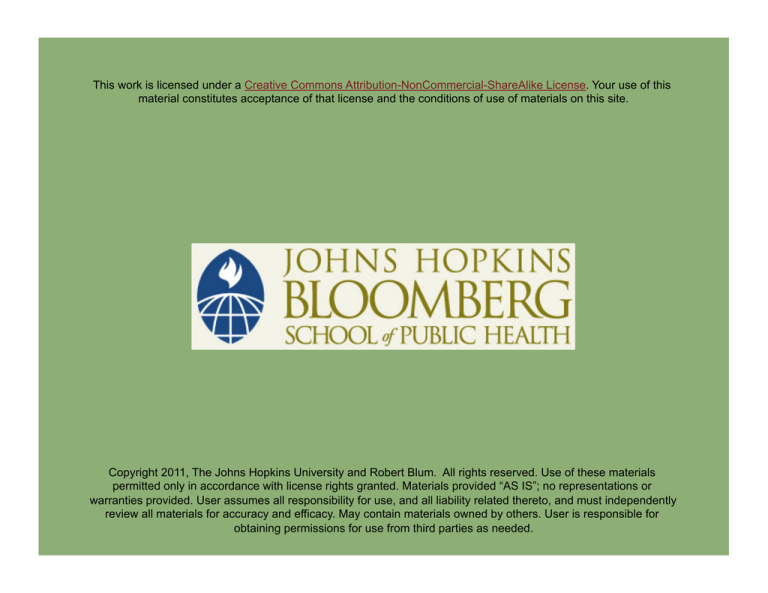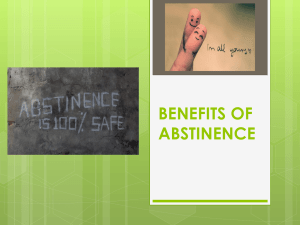
This work is licensed under a Creative Commons Attribution-NonCommercial-ShareAlike License. Your use of this
material constitutes acceptance of that license and the conditions of use of materials on this site.
Copyright 2011, The Johns Hopkins University and Robert Blum. All rights reserved. Use of these materials
permitted only in accordance with license rights granted. Materials provided “AS IS”; no representations or
warranties provided. User assumes all responsibility for use, and all liability related thereto, and must independently
review all materials for accuracy and efficacy. May contain materials owned by others. User is responsible for
obtaining permissions for use from third parties as needed.
Section D
Interventions and Implications
Interventions
Sexual and reproductive health interventions improve
knowledge and attitudes; smaller effect on behaviors
No evidence that these interventions, including sex
education, increases sexual activity
Multiple-component programs appear to be more
promising, especially if community based
Interventions usually are not rigorously evaluated
Access to services is minimal in most countries
3
Policy and Program Implications
Provide general health info and accurate sex education,
both in school and out of school
Encourage active collaboration between health and
education sectors in designing multi-pronged reproductive
health programs
Promote gender equity in the arenas of marriage and
parenthood for all social classes
4
Policy and Program Implications
Increase access to services for sexually active
adolescents (female and male)
- Contraceptive services and supplies
- STD/HIV testing and treatment
Improve maternal and child health care
- Safe motherhood is a continuing priority
Increase funding and prioritize youth needs
Address personal and societal barriers
5
Domestic Issues
Mathematical evaluation
- Abstinence—only program participants were no more likely
to delay sexual initiation
- Once sexually active, had just as many partners and were
just as likely to use contraceptives as non-participants
Increase in abstinence only education
What are teens learning?
- 24% of males and 21% of females received abstinence
education without receiving instruction about birth control in
2002, compared with 8-9% in 1995
- Only 62% of sexually experienced female teens received
information about contraception before first sex, compared
with 72% in 1995
- Only one out of three sexually experienced black males
and fewer than half of sexually experienced black females
received instruction about contraception before first sex
6
Domestic Issues
What are teachers teaching?
- More than nine in ten teachers believe that students
should be taught about contraception, but one in four
are prohibited from doing so
- In 1999, one in four sex education teachers taught
abstinence as the only way to prevent pregnancy and
STIs—a huge increase from 1988, when the fraction
was just one in fifty
What do parents want taught?
- 82% of adults support comprehensive sex education
that teaches students about BOTH abstinence and
other methods of preventing pregnancy and STIs
- Only one out of three adults surveyed support
abstinence-only education, while half oppose the
abstinence-only approach
7
International Issues
Developed countries
- Nations with the most sex-positive sexual instruction
have the best outcomes
Societal acceptance of adolescent sexual
relationships
Comprehensive information about sexuality
Clear expectations about preventing pregnancy
and STIs
8
International Issues
Developing countries
- Adolescents’ knowledge of HIV prevention remains
dangerously superficial
In a four country study (Burkina Faso, Ghana,
Malawi, and Uganda) at least half of 15–19 yearolds did not receive any sex education
- Fewer than 40% could both correctly identify
ways of preventing the virus and reject
common myths about HIV
- Even fewer could provide correct information
about preventing pregnancy
9
Annual Guttmacher Pop Quiz
1. What percentage of Americans are not virgins when they get
married?
a) 50%
b) 75%
c) 95%
2. In Uganda, where abortion is illegal under nearly all
circumstances, how does the abortion rate compare to that of
the United States?
a) It is more than twice the U.S. rate
b) It is less than half the U.S. rate
c) There are virtually no abortions in Uganda
3. In the United States, from 1995 to 2002, the proportion of
teens receiving formal instruction about birth control methods:
a) Increased among both genders
b) Declined among both genders
c) Declined among males but not females
10
Pop Quiz
4. In the West African nation of Ghana, what percent of 15-19 year old
girls think they cannot get pregnant if they have sex standing up?
a. 1%
b. 7%
c. 21%
5. Among women having an abortion in the United States, what percent
identify themselves with a religion?
a. 26%
b. 33%
c. 78%
6. Which of the following statements about emergency contraception
(EC) is true?
a. In the U.S., EC must be kept behind pharmacy counters
b. Women under age 18 in the U.S. still need a prescription
c. The U.S. government does not distribute EC through its foreign
aid programs
d. All of these statements are true
11
Pop Quiz
7. For every $1 the U.S. government spends on family
planning services under Title X, how much is saved in
pregnancy-related health costs?
a. $1.90 for every $1
b. $2.60 for every $1
c. $3.80 for every $1
8. The 24% decline in teen pregnancy in the United States
between 1995 and 2002 is mainly the result of:
a. A sharp decline in adolescent sexual activity
b. An increase in oral and anal sex and a decrease in
vaginal sex
c. Improved contraceptive use
d. Widespread fear of HIV/AIDS and other sexually
transmitted infections
12
Pop Quiz
9. In Sub-Saharan Africa, where the AIDS epidemic has hit
hardest, condom supplies amount to about how many
condoms per man per year?
a. 100
b. 50
c. 5
10. True or False: Fewer than half of all sexually active adult
men in the United States receive any sexual or
reproductive health services each year
a. True
b. False
13
Annual Guttmacher Pop Quiz
1. What percentage of Americans are not virgins when they get
married?
a) 50%
b) 75%
c) 95%
2. In Uganda, where abortion is illegal under nearly all
circumstances, how does the abortion rate compare to that of
the United States?
a) It is more than twice the U.S. rate
b) It is less than half the U.S. rate
c) There are virtually no abortions in Uganda
3. In the United States, from 1995 to 2002, the proportion of
teens receiving formal instruction about birth control methods:
a) Increased among both genders
b) Declined among both genders
c) Declined among males but not females
14
Pop Quiz
4. In the West African nation of Ghana, what percent of 15-19 year old
girls think they cannot get pregnant if they have sex standing up?
a. 1%
b. 7%
c. 21%
5. Among women having an abortion in the United States, what percent
identify themselves with a religion?
a. 26%
b. 33%
c. 78%
6. Which of the following statements about emergency contraception
(EC) is true?
a. In the U.S., EC must be kept behind pharmacy counters
b. Women under age 18 in the U.S. still need a prescription
c. The U.S. government does not distribute EC through its foreign
aid programs
d. All of these statements are true
15
Pop Quiz
7. For every $1 the U.S. government spends on family
planning services under Title X, how much is saved in
pregnancy-related health costs?
a. $1.90 for every $1
b. $2.60 for every $1
c. $3.80 for every $1
8. The 24% decline in teen pregnancy in the United States
between 1995 and 2002 is mainly the result of:
a. A sharp decline in adolescent sexual activity
b. An increase in oral and anal sex and a decrease in
vaginal sex
c. Improved contraceptive use
d. Widespread fear of HIV/AIDS and other sexually
transmitted infections
16
Pop Quiz
9. In Sub-Saharan Africa, where the AIDS epidemic has hit
hardest, condom supplies amount to about how many
condoms per man per year?
a. 100
b. 50
c. 5
10. True or False: Fewer than half of all sexually active adult
men in the United States receive any sexual or
reproductive health services each year
a. True
b. False
17




